Updated 13th September, 2016 – with new information
I’ve updated this piece based on recent information and learning. I have added to what I knew previously, nothing has been changed or deleted.
Thank you to all the readers who have shared and continue to share information that enables these discoveries. I appreciate it.
———————————————————————————————————————
🙂 – to be honest, most people will not be familiar with these fruits.
Monkey Cola
First seen – August 2011, Port Harcourt
The first time I came across this fruit, I was intrigued by its crunch and taste – halfway between fresh green peas and carrots and frustrated because I couldn’t find it botanical name.
Related to the Kola nut, this ‘fruit’ is commonly eaten by moneys in the forest around southern Nigeria and Cameroun. This orange variety is one of several, including yellow and white.
It is great as a snack and delicious in a relish.
‘Local Strawberry’
First seen – July 2014, Port Harcourt
Named – August 2016, Lagos, as Olohun (read the blog post for more)
One of the reasons I miss Port Harcourt is the way it introduced me to fruits and vegetables I wasn’t familiar with. Like this, called Local Strawberries. I know, they look nothing like strawberries…
It took me a while to find anyone who knew them. A colleague of mine finally gave me a clue that led me to think they are the same as the Brazilian Jabuticaba.
He said the fruit grew off the trunks of the tree. And so I began my internet search and that led me to Jabuticaba.
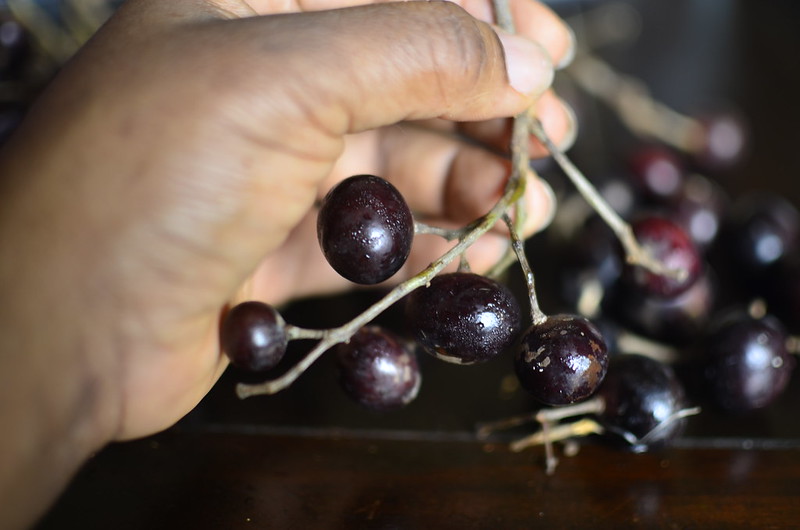
The fruit is a thick-skinned berry and typically measures 3–4 cm in diameter. The fruit resembles that of a slip-skin grape. It has a thick, purple, astringent skin that encases a sweet, white or rosy pink gelatinous flesh. Embedded within the flesh are one to four large seeds, which vary in shape depending on the species; Wikipedia
And then a few months ago, we were at Freedom park in Lagos and what did I see? This tree.
Yes, the same sort, with green fruit.
I haven’t been back to check if the fruit is ripe but I will do soon.
In August of 2016, I learnt that these are known as Olohun, common in Nigeria and parts of West Africa. Read the post here.
Ube Ukpoko/ Atili
First seen – October 2014, Port Harcourt
I always thought these were Ube, African butter pear till I bought some one day and realised they were different.
Thanks to Natural Nigerian, I found out its name.
More information available here
June Plums
First seen – December 2014, Port Harcourt
More information available here
All you need to know about this fruit is you should never just take a bite. It has a big-a** spiky seed that could wreck havoc on tongue and mouth. Beware.
Saying that, it is a delicious ‘plum’, which made a gorgeous pepper jam, served at a Christmas table past.
Ackee, aka Ishin
First seen – February 2015, Lagos
So one day, I’m heading to a meeting out of the office and we drive by a street in Ikoyi, Lagos. I see a tree full of fruit and don’t stop but note the location.
That’s the route I take home that evening.
I stop by and see a tree full of fruit. Initially, I thought it was the rose/ mountain apple but on closer look, discovered it wasn’t. The men who stood and worked under the tree called it ‘Ishin’, in Yoruba. They told me the fruit opened up when ripe and not to eat it in its unripe state as it was poisonous.
The ackee tree is indigenous to West Africa, where it is called ankye or ishin. Thomas Clarke, Jamaica’s first botanist, introduced the plant to the island in 1778. However, the ackee tree, Blighia sapida, was named after the infamous Captain William Bligh who took the breadfruit tree to the West Indies. The tree also grows in other West Indian Islands such as Cuba, Haiti and Barbados, in Central America, and in Southern Florida; eMedicene
Google led me to the Ackee, which is surprisingly indigenous to Nigeria and West Africa, not Jamaica where it is soooooooooo well know.
An association between ackee poisoning and Jamaican vomiting sickness was first noted in 1875 and documented in 1904. In 1937, Jordan and Burrows found a water-soluble toxic material in the seed and pods of the ackee fruit. In 1954, Hassal et al were the first to isolate 2 toxic compounds in their crystalline form. These compounds were called hypoglycin A and hypoglycin B because of their hypoglycemic activity; eMedicene
So there, five rare/ uncommon Nigerian fruits.

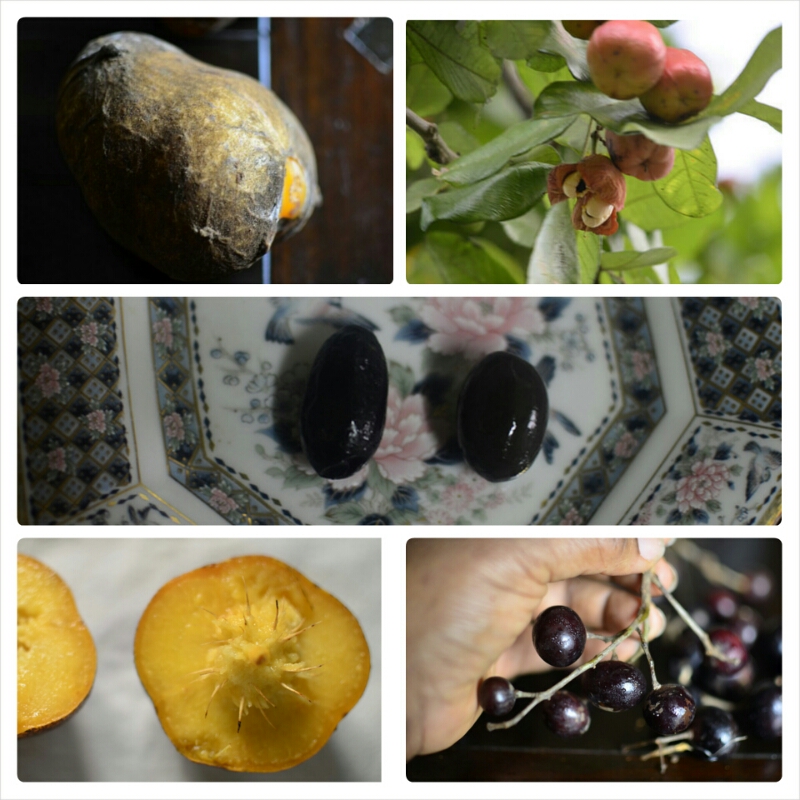
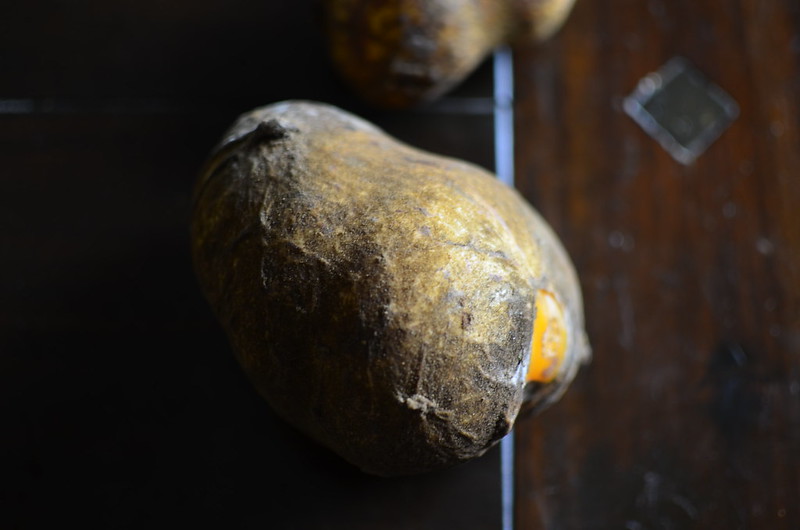
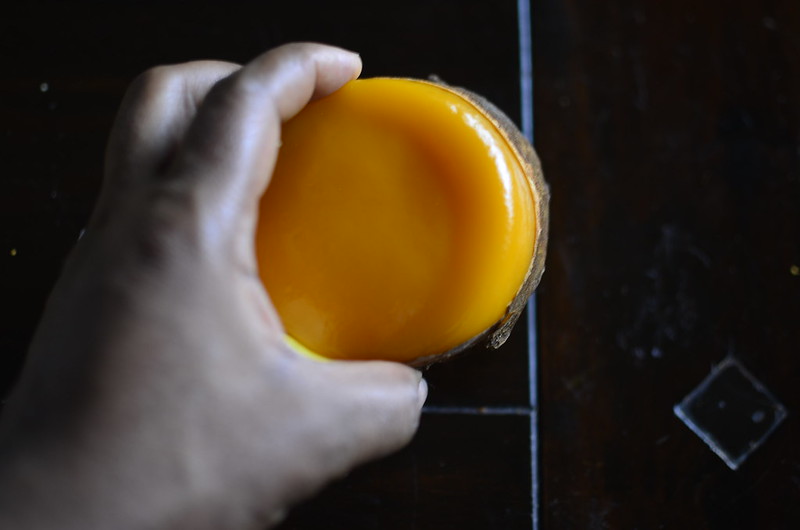
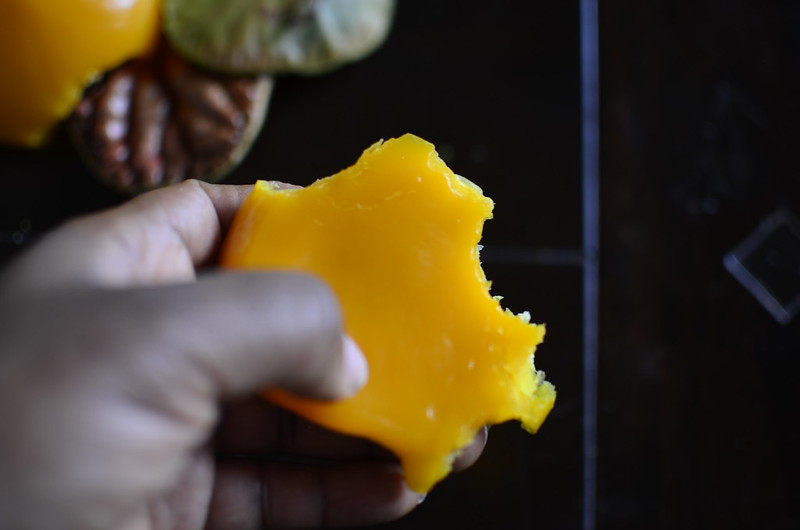

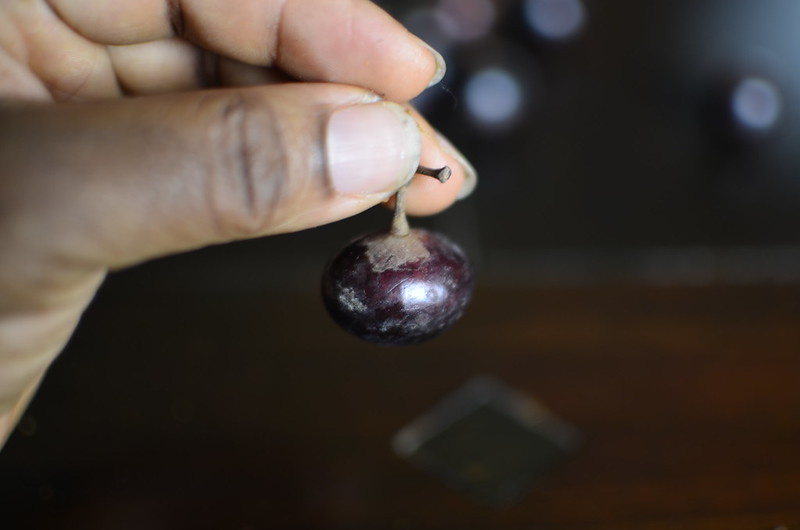
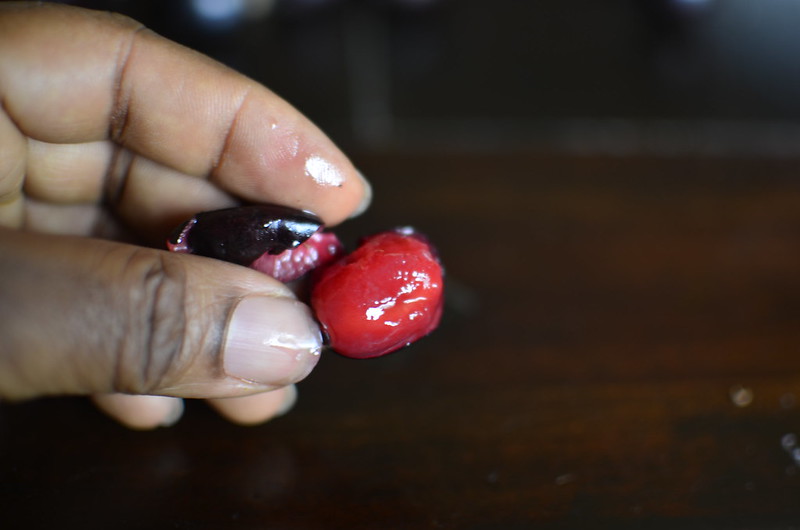
![2014-11-15_11.25.40_1[1]](https://farm9.staticflickr.com/8825/17039409062_d3686accbb_c.jpg)
![2014-11-15_11.25.47_1[1]](https://farm9.staticflickr.com/8737/16420703513_95f5cd2e78_c.jpg)
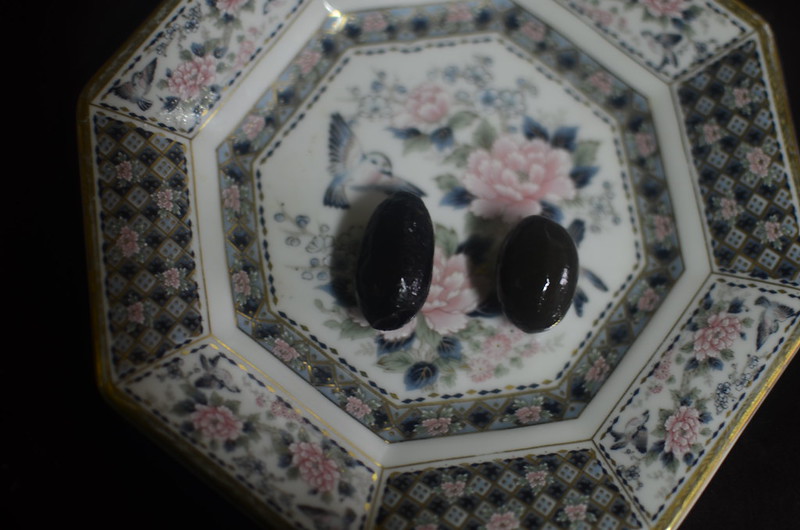
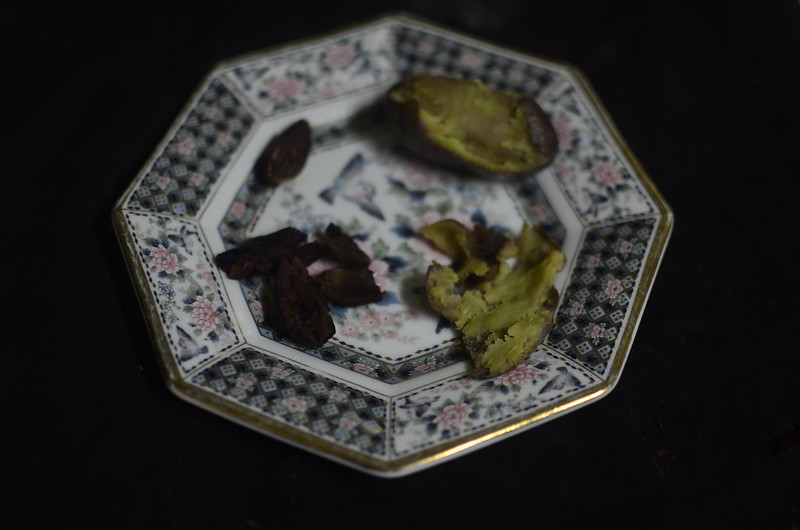
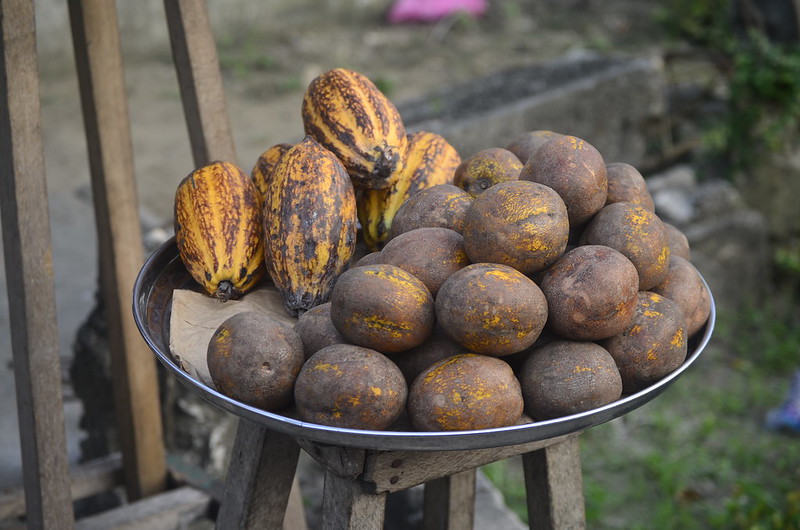
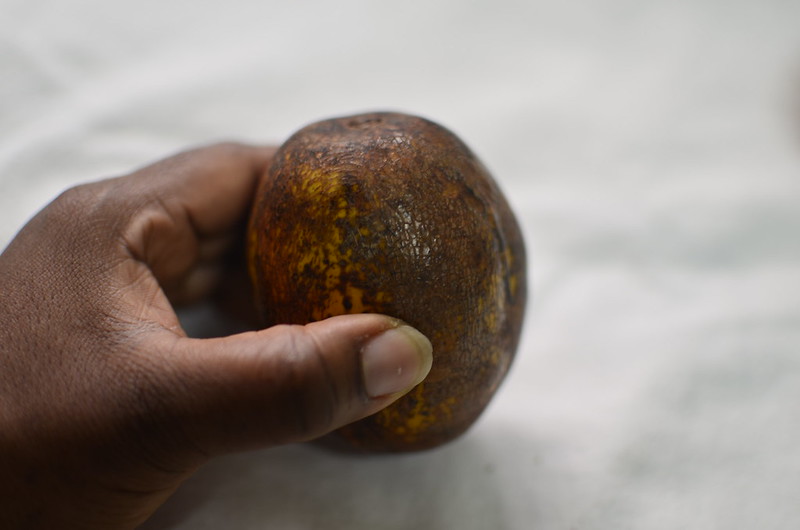
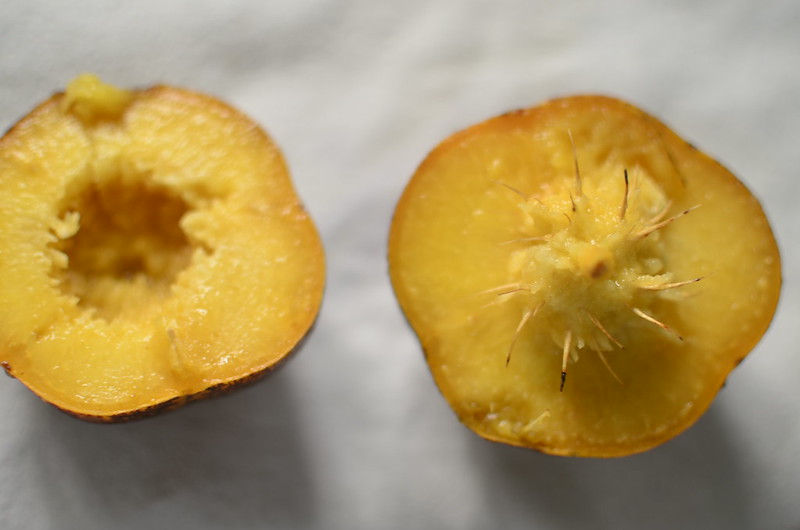
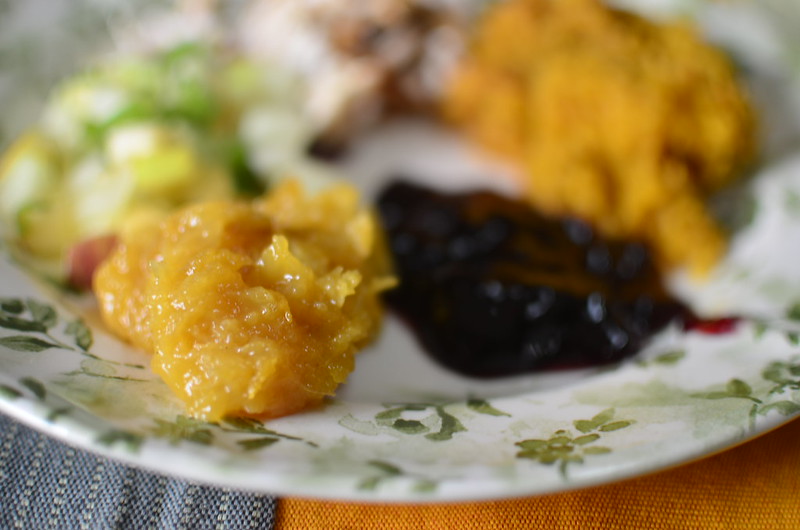
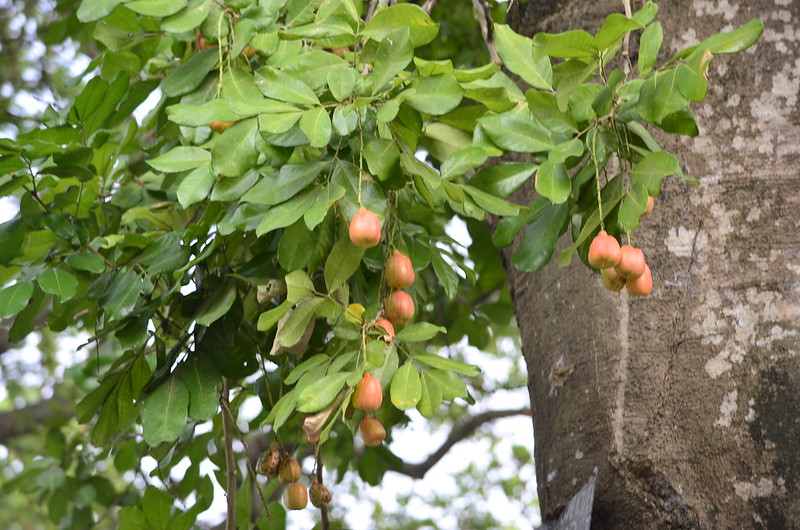
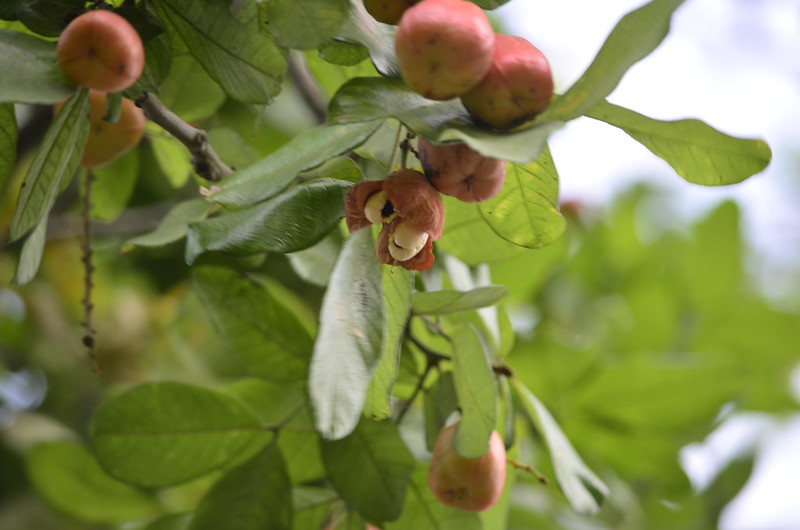

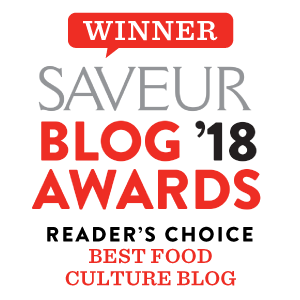
We have the June plum, yellow monkey kola, red passion fruit, jack fruit, dragon fruit, fig, sugar apple or sweetsop, giant banana, soursop, raspberry, mulberry, butter avocado, strawberry, sweet potatoes, spondias mombin, pomegranate, grape vine …
Hello Ozioma, Please do you sell seedlings?
Hi, no I don’t sell seeds.
Yeah I sell seedlings. Which fruit seedlings do you want to buy?
I am in IMO state.
08037673530
You full name so I can contact you. This page to accept email or number sharing.
Hello Ozioma. I need some of the plants you listed. How do I contact you?
Yeah I sell seedlings. Which fruit seedlings do you want to buy?
I am in IMO state.
Please do you know the native name for cranberry
No I dont have the native name for cranberry. It isn’t local so I’m not sure if a native name exists in any language
Please where can I get the atili in Lagos please!!?I have really been craving for it
I cant even sleep rn
Just thinking about it
When it’s in season, I order from Earth Fresh Foods in Jos – https://www.instagram.com/earthfreshfoodsng/
Dear Mts Fifi Gray the Osu seed is called Hunteria Umbellata in English and Abeere in western part of Nigeria. the bitter fruit is mainly used to control diabetes, cure fever and leprosy.
Me too…. When I was living in Port Harcourt . I was introduced to and ate a lot of fruits…
A fruit in Abuja called Cherry Prune. It has light flesh on the seed that you lick. It has a semi hard red shell and wrinkles like a prune when it ripens. Does anyone know it?
Anyone heard of the large green bitter fruit called Osu or Osun in Benin City or Nkpokiri in the East?
Yes, I just learnt about it a few weeks ago and asked someone to buy and send it to me from Benin City. It has very powerful hypoglycemic powers – meaning it lowers blood sugar levels drastically and must be a local herb used to manage diabetes.
I tried it and must say it must be taken with care while monitoring one’s blood sugar levels.
Hi Eric,
I need it the said fruit called OSU or oshun. Can l have your contact.
There is black like berry fruit in East called mbembe. I searched for it’s English names and I have seen names like Black plum and acai fruit as the names and they both look exactly like it. The fruit has a a slightly black coating that you also eat when taking it. The inside is a mix of black, brown, purple like colour. The seed is coated with a fur like substance that is also black
Can gooseberries be gotten in nigeria and where precisely?
I should imagine you mind find them in international stores, maybe Shoprite
do check out the sweet yellow chabbule seasonal fruit along with tuttuje or jinin kafiri up north, if you also check a documentary on gashaka gumti national park entitled ‘Nigeria’s eco treasury’ there is a succulent looking fruit that the cameraman said he longed for but could not eat because he is seeing the fruit for the first time. he is from the grassland and knows little about some forest fruits. Is that fruit edible?
Thank you!
I am happy to get to this site. I will like to get in touch with any one who can provide these seeds for me to plant in my house. I am in Port Harcourt
I don’t know anyone at the moment. Cheers
I have seen Local Strawberry in Abuja. When i saw it my first thought was blueberry. Now i know its same as Brazilian Jabuticaba. interesting!
Thanks but no, it isn’t Jabuticaba; it is Olohun.
Jabuticaba is different from the berry-like fruits you found at Port- Harcourt and displayed. The inside of the ripe jacuticaba is white while that of the one displayed is redish-purple. Pls research more. I really need the one from PH. It’s also in Benin Forrest. As kids we used to go get them in the forrest and make the into wine in the 70’s. How can I get the seeds for planting. Pls help
Thank you.
I don’t have any additional information about where you might find it.
I know isin. I used to eat it when I was young. We also make stew with it which we use to eat eko
Really? I’ve never tried it. I’d love to someday
They sell this in packed Tins at Afro Caribbean shops in the UK. I couldn’t stop smiling when I saw it as it brought back memories.
I came here because I am purposely looking for rare fruits which can be sold. I grew up in my village and there are lots in Igbo land. I will give some of their names in Igbo: Agbaka (the pear you showed above), the June Plum, uvune, udi, utu, ubia and ubiri. I have only seen udi, uvune, ubia and ubiri in my village. The rest I have seen elsewhere. Ubia and ubiri have very beautiful aromas that can be used for organic soaps and creams of the likes of Body Shop.
Originality. Good job. In love with nature. I believe we have alternatives to every fruit we order from abroad. Recently I took a deeper look at tangerine and was comparing it to the kidney- fantastically similar compared with the kidney bean except for its colour.
Pls how do we domesticate these fruits to make them readily available in our markets.
It is painful our nutritionists are not helping matters in identifying these local fruits and vegetables vital for our health rather their publications recommend such fruits and vegetables not available in Nigerian markets; they only copy resources or materials published by foreign authors with foreign recipes.
Does anyone know whats the local name of the berries that ortiney syrup is derived from.
Thanks for your educative post. Ive known the Ube Akpoko/atili since my childhood cs its very common around Olamaboro, Ankpa LGAs and neighbouring areas of Igala land in Kogi State whre I hail from. I was told that just like the Ube, some of our elders who had travelled to Ibo land for business,education etc introduced both to Igala land. In fact we have an Ube tree of over 35 years standing in my family compound as we speak and it was said that My late uncle brought the seed from Ibo land during his primary school there. The Ube Akpoko/Atili is cooked and spiced up with pepper and salt, it is also commonly hawked in the streets. Its seed has a harder shell than Ube.
Kitchen Butterfly, Good work. Am not into kitchen though, rather into endangered and under-exploited African (Nigerian) plants. I appreciate your effort to find such fruit.
I will share some more with you when i find such during my expiditions.
Thank you so much – I appreciate it
I have never seen any of those above fruit and can it be gotten in Lagos, because I love coming up with recipes and I know I can do a lot with them.
My ‘local strawberry’ intrigued me know most, how can I get them pls
The only one I’ve seen in Lagos is the Ackee, all others I got in Port Harcourt. If I see them here, I’ll let you know.
Of these fruits which one has export value? Pls contact me if any.
Thanks.
It’s the seasonality and the cultivation of these fruits that limits usage. Our next steps is to look into preservation.
Hi! The “local strawberry”… The green ones which grow on the trunks..are they bigger than normal strawberry size or is it just the picture? The green ones look like Marula fruit in South Africa!
Thank you so much for this! I’m in PH and I can’t wait to get my hands on the strawberries when in season and make me some strawberry jam!!
You rock!
Nice the strawberry fruith is readily available here in PortHarcourt. I wish you are still around id make it available to you my namesake Uzoma
Hi! The “local strawberry”… The green ones which grow on the trunks..are they bigger than normal strawberry size or is it just the picture? The green ones look like Marula fruit in South Africa!
Thank you so much for this! I’m in PH and I can’t wait to get my hands on the strawberries when in season and make me some strawberry jam!!
You rock! Will follow you!
Good day everyone,,please what is pomegranate called in yoruba language?
The “local strawberries” are not jabuticaba. I have been searching for it’s botanical name but I have yet to find it.
The Local berry is called Blackberry it can be found in The Swamps of Buguma in Rivers State Nigeria…and not Jabuticaba… Monkeys love it so Much
Thank you so much
Wow! I’m especially fascinated about the ackee, to think that its indigenous to Nigeria is amazing. Well done.
The local strawberries are called OLOHUN in Yoruba. When licked it turns your tongue into purple colour. Used to be school children’s street delicacy. Last saw it about 55 years ago!
Thank you SOOOOOOOOOO much. Thank you
[…] Image source […]
this is wonderful dear, was just telling a colleaque of mine today of the monkey cola and we bought it, that was nice. but do u have idea of it nutritional content?
Thank you so much. Yes, Monkey Cola has substantial amounts of iron, zinc, and copper; the B-vitamins and vitamin C (http://www.ncbi.nlm.nih.gov/pubmed/26433302)
[…] & Photo Credits: BudgetNutrition, Naij.com, KitchenButterfly.com, Pharmanewsonline.com, ijsk.org, […]
Good expository talk on our indigenous plants. I’ll be glad if I can get some quantities of these seeds, especially the South South/Port Harcourt ones for Scientific study/analyses.
Thank you.
Thanks Prof – I don’t have any but I’ll see if I can dry some when next I find the fruits.
Hello Prof,
Please do you do research on indigenous plants normally? I think I am interested in your resserch. I do natural products for hair and skin. Please contact me uofoma@gmail.com. Thank you.
I am interested in natural products for hair and skin.
Thanks for this post. Lovely. The delicious “plum” looks ferocious. My gums suddenly went sore.
Lol, they aren’t a joke those plums!
nice post. i was looking for a way to get ackee seeds to experiment . i wonder if you know what its called in efik or southern nigeria so i could go investigate in the market. i discovered today that the local beni seeds are actually sesame seeds. open sesame, made pasta and toasted a chunk of them into my food. heartburnt burp. okay now.
Thank you so much – no I don’t know what the name is in Efik. If I find out, I’ll let you know
Well! who would have thought we have this much variety if fruit! And monkeys? Why have I not ever seen a monkey?!
Lol. I do not mind not seeing any monkeys :). We have such variety…unreal.
We call Monkey Cola Ndiya here in the South South. Love it! Although not so fond of the occasional worms that I seem to narrowly miss biting into. Would love to try all the others. And look at that, we have ackee here!!!!
Yes, Ndiya. I haven’t been fortunate to encounter any with worms lol…praise God. There’s so much diversity in our produce amazing.
Ha, this is amazing. I didn’t know the orange fruit was called Monkey Cola. I thing we used to call it African Mango or Crunchy Mango or something like that growing up but we used to eat it! Oh my! What a goldmine of fruits. Thanks for sharing.
If that’s bush mango, then the seed is what you dry to make Ogbono seeds. No?
Yes, it is
Lovely capture. The only two i have seen are the monkey cola and the pear. I have a very very vague memory of the monkey cola i remember it being crunchy like carrot, and the taste a cross between pawpaw and maybe carrot. I consumed the pear in FGGC Onitsha many years ago. We had hawkers bring it in to sell on weekends. I have not seen it since then.
The June Plum I recognise as Golden Apples. The ones from the tree in Freedom Park look like a type of what Jamaicans call Guineps, but it’s hard to tell without seeing the fruit close up.
Yay Noni, thank you very much. For the Golden Apple name.
And yes, the guineps look very similar to the ‘local strawberries’…perhaps they are a different variety from the typical green ones. I’ll look for examples of the fruit without its skin.
Thank you again.
Wow. Nigeria is a treasure trove of amazing fruits and vegetables. I grew up around Ishin, I wasn’t a big fan as a kid.
Really – so much still to discover which is amazing for us, methinks. I haven’t tried Ishin – once it ripens, I’ll let you know what I think 🙂